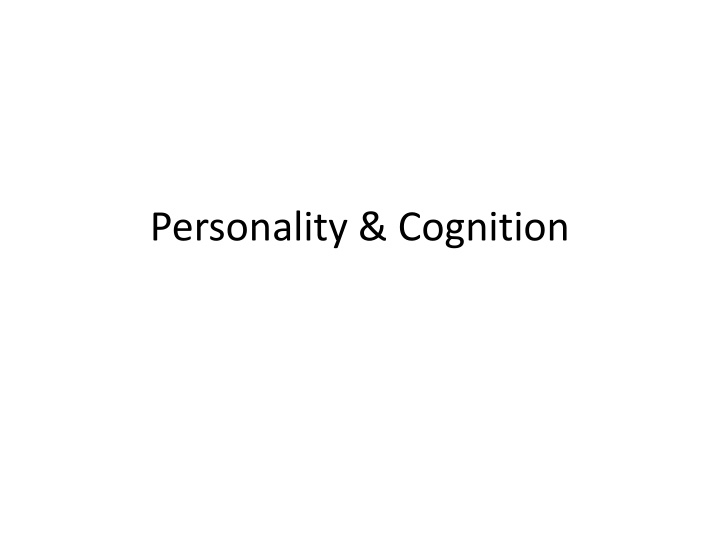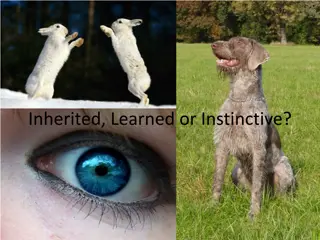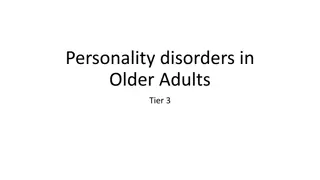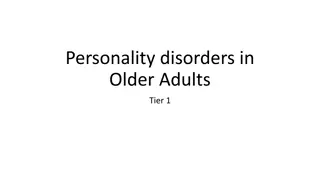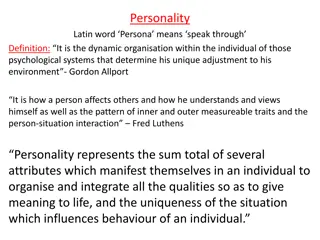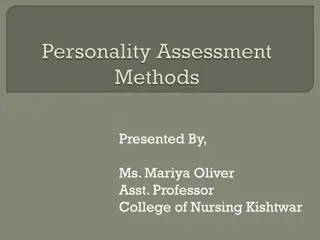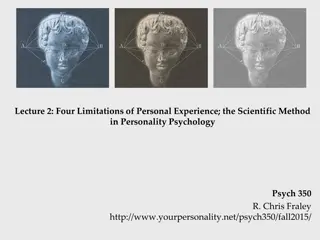Personality & Cognition Traits Across Cultures
Personality research focuses on behavior that is typical of an individual and how it varies across different cultures. Traits like motive, temperament, and trait play a significant role in defining enduring characteristics of a person. The Eysenck Personality Questionnaire is a frequently used instrument for cross-cultural comparison studies, distinguishing dimensions like neuroticism, extraversion, psychoticism, and social desirability. The concept of temperament, more biologically rooted than personality traits, sheds light on inter-individual differences across cultures.
Download Presentation

Please find below an Image/Link to download the presentation.
The content on the website is provided AS IS for your information and personal use only. It may not be sold, licensed, or shared on other websites without obtaining consent from the author.If you encounter any issues during the download, it is possible that the publisher has removed the file from their server.
You are allowed to download the files provided on this website for personal or commercial use, subject to the condition that they are used lawfully. All files are the property of their respective owners.
The content on the website is provided AS IS for your information and personal use only. It may not be sold, licensed, or shared on other websites without obtaining consent from the author.
E N D
Presentation Transcript
Traits across cultures Personality research is concerned with behavior that is typical of a person and distinguishes that person from others. It is a lifelong process of interaction between an organism and its ecocultural and sociocultural environment. The effects of these external factors make it likely that there are systematic differences in the person-typical behavior of people who have been brought up in different cultures.
Traits across cultures In the field of personality research there are various terms, such as motive, trait, and temperament, that refer to enduring characteristics of a person. Temperament, for example, refers more to the biological basis of behavior, while motives and traits can be associated with influences of the social environment.
Traits across cultures Personality traits: a lasting characteristic attributed to persons in varying amounts of strength. The uniqueness of a person is represented by a specific mixture of the various traits. Personality traits are usually measured by means of self-report personality questionnaires (for specific traits) or personality inventories.
Eysencks Personality Scales One of the more frequently used self-report personality instruments for cross-cultural comparison studies is the Eysenck Personality Questionnaire. In the EPQ four personality dimensions are distinguished: psychoticism extraversion neuroticism social desirability.
Eysencks Personality Scales Neuroticism or emotionality represents a dimension ranging from instability, with moody and touchy as characteristic features, to stability, characterized by an even temper and leadership. Extraversion stands for a dimension from sociable and outgoing or extraverted behavior, to quiet and passive or introverted behavior. The third dimension, psychoticism, has tough-mindedness and tender-mindedness as its opposite poles. This dimension is a later addition to Eysenck s theory and conceptually somewhat less developed. Social desirability refers to the tendency to give responses that are socially acceptable and respectable. This tendency has been mentioned as the most important determinant of responses in self-report personality tests
Temperament The concept of temperament, more than that of personality traits, refers to a biological basis of inter-individual differences. Some, small-scale, studies of temperament with infants have suggested that East Asian (Japanese and Chinese) babies are less excitable and easier to calm when upset than American babies.
Temperament Reactions of Japanese and American infants to an inoculation (a lama) were observed. On average the American babies showed a more intense reaction in crying and other signs of discomfort. However, measurements of cortisol level- a hormone that is excreted (salg lanmak) more under conditions of stress- showed a more intense reaction among the Japanese infants.
Temperament Pattern between overt behavior (crying in American babies) and biochemical reactions (high cortisol levels in Japanese babies) is not clear. But the discrepancy can serve as a warning that inferences about temperament as an inborn characteristic.
"Big five" Dimensions The five-factor model (FFM) has become the most popular model of trait dimensions. extraversion, with sociability, seeking stimulating social environments, and outgoingness as some of the important characteristics; agreeableness, with compassion, sensitivity, gentleness, and warmth; agreeable persons are good to have around; conscientiousness, with persistence, goal-directed behavior, dependency, and self-discipline; neuroticism, with emotional instability, anxiety, and hostility; the neurotic person is tense, while the emotionally stable person is secure and relaxed; openness to experience, with curiosity, imaginativeness, and sophistication.
"Big five" Dimensions Cross-cultural research has been conducted mainly to establish the universal validity of the FFM. If the five dimensions represent basic tendencies of human functioning, they should be replicated everywhere. In various studies factor structures similar to those in the USA have been found in countries as far apart as France and the Philippines.
MMPI Apart from studies with the Eysenck scales and the big five, traditions have developed around the Minnesota Multiphasic Personality Inventory (MMPI). Both the MMPI and the MMPI-2 have been used on a large scale in the diagnosis of personality and abnormal behavior virtually across the globe.
MMPI MMPI-2 was (officially) available in twenty- two languages with a number of other adaptations in progress.
Effects of the environment It should also be noted here that there are approaches in which personality is seen more as a reflection of how individuals experience their own environments. Subjective well-being (SWB), which refers to a broad category of evaluations about life satisfaction, both in general, and in specific domains, like work, family, health, etc. SWB is predicted consistently by personality factors, including temperamental predispositions.
Effects of the environment Across countries national wealth has been found to be strongly correlated with SWB, and also individualism, human rights, and social equality.
Effects of the environment An extensive tradition of cross-cultural research exists in respect of locus of control. The locus of control can be perceived as internal or external to oneself. Success in life can be due to skill or to chance and so can failure. Many events that happen in persons lives can be taken by them as their own responsibility or as beyond their control.
Self in social context The notion of a person as a bounded individual has been central to the discipline of psychology. The possibility that person and selfhood are cultural constructions, and hence likely to vary cross-culturally, has become an issue in theoretical and empirical research only fairly recently. Does the concept of person vary cross- culturally?
Self in social context Triandis (1989) examined three aspects of self (private, public, and collective) as they were exhibited over three dimensions of cultural variation individualism collectivism tightness looseness cultural complexity.
Self in social context Societal tightness was also linked to high sampling of the collective self, while the more complex the culture, the more frequent was the sampling of the private and public self. Child rearing and other ecological and cultural factors are proposed to account for these patterns, although they remain largely unspecified.
Self in social context Ka t ba (1990, 1996) has differentiated between a relational self and a separated self. The relational self develops in societies with a family model of emotional and material interdependence. In societies have typically a traditional agricultural subsistence economy with a collectivist life style, members of a family have to rely on each other in case of sickness and to have old age security.
Self in social context A separated self is found in individualistic Western urban environments with a family model of independence. Members of a family can live separated from each other without serious consequences for their well-being.
Self in social context Ka t ba distinguished a third category of self, that develops in a family model of emotional interdependence. This kind of self is called an autonomous- related self ; it is found particularly in urban areas of collectivist countries (Like Turkey). Depite growing material independence, and socialization towards more autonomy, emotional interdependencies between members of the family continue.
Self in social context Ka t ba believes that the main direction of development in the world is towards this third model, allowing for relatedness as well as autonomy in a person s interactions with society at large.
Self in social context A twofold distinction between an independent self and an interdependent self has been advocated by Markus and Kitayama (1991). They postulate that people in various cultures have strikingly different construals of the self. These different construals have consequences for how persons experience themselves and others, and for cognition, emotion, and motivation.
Self in social context Generally the Western conception of self is of an individual who is separate, autonomous, and atomized, seeking separateness and independence from others. In contrast, in Eastern cultures relatedness, connectedness, and interdependence are sought, rooted in a concept of the self not as a discrete entity, but as inherently linked to others. The person is only made whole when situated in his or her place in a social unit.
Self in social context The independent construal of the self further implies that persons see themselves as unique, promote their own goals, and seek self-expression. Persons with an interdependent construal of the self seek to belong and fit in, to promote others goals, and to occupy their proper place.
Conceptions of the person Psychological concepts and theories are being contributed by scientists from many cultures. Those proposed from non-Western societies are often referred to as indigenous personality concepts.
Conceptions of the person Amae in Japan Amae is described as a form of passive love or dependence that finds its origin in the relationship of the infant with its mother. Amae is more prominent with the Japanese than with people in other cultures. Japanese language has a word for amae and that there are a fair number of terms that are related to amae.
Conceptions of the person The seeking of the other person s indulgence that comes together with passive love and dependency leads to a blurring of the sharp distinction, found in the West, between the person (as expressed in the concept of self) and the social group. Mental health problems manifest in psychosomatic symptoms and feelings of fear and apprehension can have their origins in concealed amae.
Conceptions of the person Amae has aspects of both dependency and attachment, with aspects of regression to refuse the reality of separation and to acquire emotional and physical comforts from the target of affection.
Conceptions of the person Reciprocal amae in TV shows like Seinfeld and Friends, where the characters come and go in each other s apartments (and refrigerators). It s the presumption that these kinds of behaviours are allowed between close friends that makes this amae.
Conceptions of the person Jiva in India The concept of jiva is similar to that of personality. The jiva represents everything concerning an individual, including all her experiences and actions throughout her life cycle. In jiva, there is a real self or Atman, that is the permanent unchanging basis of life.
Conceptions of the person The outermost is the body. The next is called the breath of life ; it refers to physiological processes such as breathing. The third layer involves sensation and the mind that coordinates the sensory functions. Here egoistic feelings are placed that have to do with me and mine. The fourth layer represents the intellect and the cognitive aspects of the person, including self- image and self-representation. The fifth and most inner layer of the jiva is the seat of experience of bliss.
Cognitive Functioning Cognition is an area of cross-cultural research that has a history of strong controversies. There are authors who see such differences as a direct reflection of variation in inborn competencies (biological explanation). Racial differences
Cognitive Functioning It is a more common viewpoint that cognitive processes are embedded in culture. Cultural groups have different ability patterns, rooted in ecological demands as well as sociocultural patterns. It is accepted that cognition is a culture- specific domain of psychological functioning.
General intelligence General intelligence (g) is largely based on psychometric evidence, particularly the consistent finding of positive correlations between results obtained with tests for different cognitive abilities. Spearman: considers g very much as an inborn capacity.
General intelligence Humphreys: found that loadings of g correlated .17 with race and .86 with socioeconomic status differences. Scores were analyzed for participants of low and high socioeconomic status and for African Americans and European Americans separately. Performance differences were attributed to adverse (olumsuz) environmental factors (SES) which affect all individuals to the same extent, irrespective of race.
General intelligence It should be clear that biased tests and observations will lead to wrong interpretations. Some data sets were from military draft registrants and were based on the same test that had been administered for many years. BUT... It was suggested that IQ tests do not measure intelligence as a general capacity, but have only a weak link to it.
General intelligence Cognitive developmental processes are likely to reflect interactions between organism and environment.
General intelligence Problems in ability testing Tests presuppose all kinds of conventions and values that are shared by a test taker and the test administrator. While much ability testing across cultures has ignored these issues, and sometimes continues to do so.
General intelligence Other approaches to general intelligence intelligence as measured by (Western) tests provides a highly biased account of what it means to be intelligent in other societies. The most useful way is accepting universal characteristics of cognitive functioning, but attempts to understand variations in the cognitive life of cultural groups from their own context.
https://www.ted.com/talks/james_flynn_why _our_iq_levels_are_higher_than_our_grandp arents?language=tr
